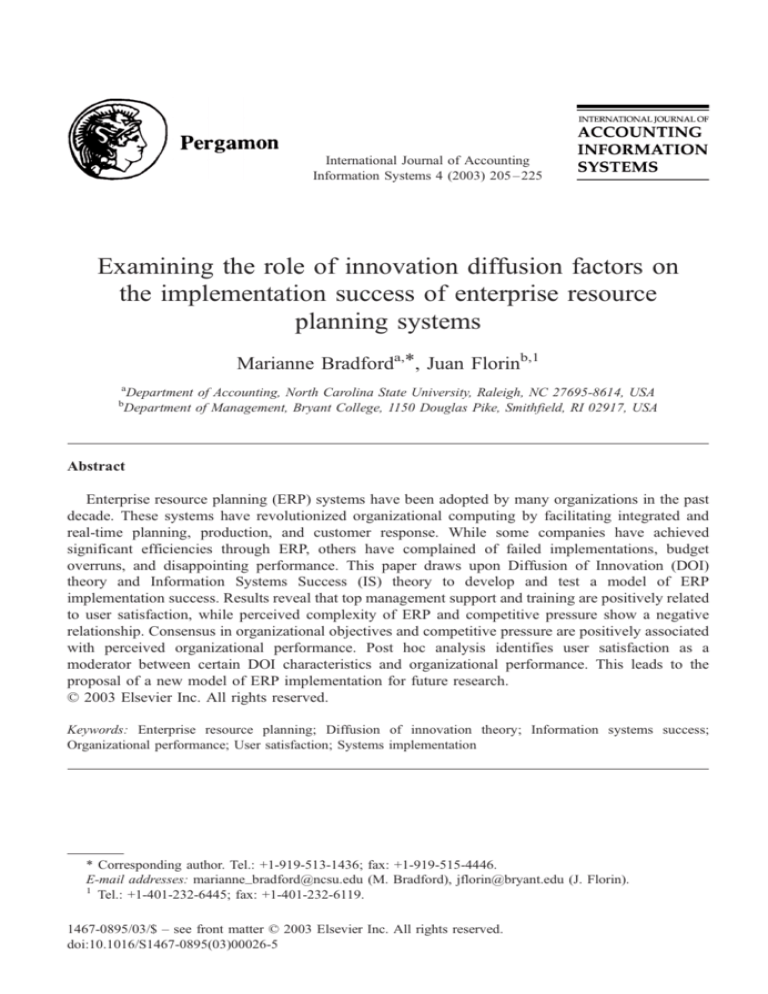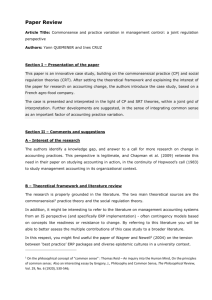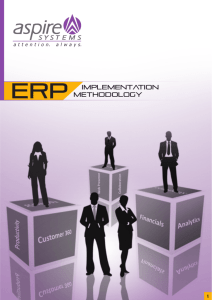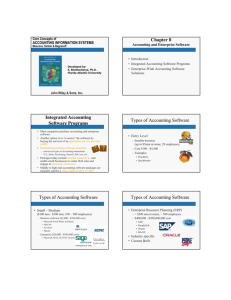
International Journal of Accounting
Information Systems 4 (2003) 205 – 225
Examining the role of innovation diffusion factors on
the implementation success of enterprise resource
planning systems
Marianne Bradforda,*, Juan Florinb,1
a
Department of Accounting, North Carolina State University, Raleigh, NC 27695-8614, USA
Department of Management, Bryant College, 1150 Douglas Pike, Smithfield, RI 02917, USA
b
Abstract
Enterprise resource planning (ERP) systems have been adopted by many organizations in the past
decade. These systems have revolutionized organizational computing by facilitating integrated and
real-time planning, production, and customer response. While some companies have achieved
significant efficiencies through ERP, others have complained of failed implementations, budget
overruns, and disappointing performance. This paper draws upon Diffusion of Innovation (DOI)
theory and Information Systems Success (IS) theory to develop and test a model of ERP
implementation success. Results reveal that top management support and training are positively related
to user satisfaction, while perceived complexity of ERP and competitive pressure show a negative
relationship. Consensus in organizational objectives and competitive pressure are positively associated
with perceived organizational performance. Post hoc analysis identifies user satisfaction as a
moderator between certain DOI characteristics and organizational performance. This leads to the
proposal of a new model of ERP implementation for future research.
D 2003 Elsevier Inc. All rights reserved.
Keywords: Enterprise resource planning; Diffusion of innovation theory; Information systems success;
Organizational performance; User satisfaction; Systems implementation
* Corresponding author. Tel.: +1-919-513-1436; fax: +1-919-515-4446.
E-mail addresses: marianne_bradford@ncsu.edu (M. Bradford), jflorin@bryant.edu (J. Florin).
1
Tel.: +1-401-232-6445; fax: +1-401-232-6119.
1467-0895/03/$ – see front matter D 2003 Elsevier Inc. All rights reserved.
doi:10.1016/S1467-0895(03)00026-5
206
M. Bradford, J. Florin / Int. J. Account. Inf. Syst. 4 (2003) 205–225
1. Introduction
Enterprise resource planning (ERP) systems have been qualified as ‘‘the most important
development in the corporate use of information technology (IT) in the 1990s’’ (Davenport,
1998, p. 122). However, implementing enterprise systems is a costly and complex undertaking. While some companies have achieved significant efficiencies through ERP, others
have complained of failed implementations, budget overruns, and disappointing performance
(Fryer, 1999; O’Leary, 2000; Jenson and Johnson, 1999).
Researchers have identified several key factors that may contribute to a successful ERP
implementation (Bingi et al., 1999; Motwani et al., 2002). Most of this research has been in
the form of case studies of individual companies and interviews with IT professionals, both of
which have provided rich accounts of the implementation process. We extend this line of
research with the theoretical development and empirical testing of a model derived from two
related literature streams, Diffusion of Innovation (DOI) (Rogers, 1983) and Information
Systems Success (IS) (Delone and McLean, 1992). Taking an organizational level perspective, we examine the relationship between innovative, organizational, and environmental
characteristics and two dimensions of ERP systems implementation success: user satisfaction
and perceived organizational performance.
To test these relationships, we use regression analysis with a sample of firms that have
recently implemented ERP systems and find that different sets of antecedents affect user
satisfaction and organizational performance. Further analysis shows that these two outcomes are not independent but interact with each other. Based on the findings from our
exploratory study and post hoc analyses of interactions, we conclude with a proposed
moderated model of ERP implementation success. The proposed model simply states that
user satisfaction moderates the relationships between DOI antecedents and ERP organizational performance.
2. Exploratory model and theory development
The success of IT implementations has been the focal point of a substantial amount
of research over the last two decades. Two theoretical streams, DOI (Rogers, 1983)
and IS implementation (Delone and McLean, 1992), have emerged, and each has been
the basis for studies examining systems success. These two literature streams have
numerous parallels as suggested by Premkumar et al. (1994), Fichman (2000), and
others. In DOI theory, ‘‘an organizational effort directed toward diffusing appropriate
IT within a user community’’ is analogous to IS implementation (Cooper and Zmud, 1990,
p. 124).
Since its inception, DOI research has evolved from a focus on variables affecting the
adoption or nonadoption of IT (Tornatzky and Klein, 1982) to its diffusion (i.e., extent of
implementation) within an organization (Premkumar et al., 1994) and more recently to the
organizational learning (Fichman and Kemerer, 1997) and performance (Ramamurthy and
Premkumar, 1995) that may result from IT initiatives. In its current form, DOI theory












